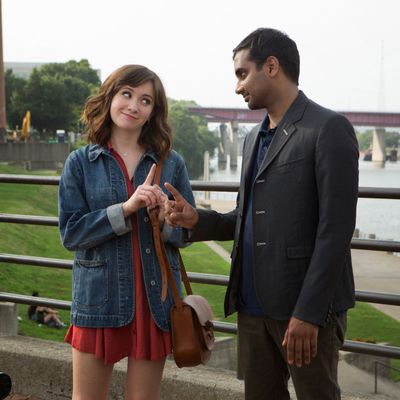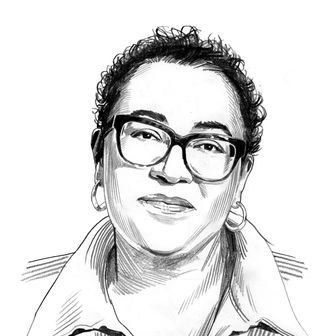
Aziz Ansari’s Master of None was released on Netflix Friday, and from buying Plan B and apple juice with a one-night stand to doing a Skype interview in a public coffee shop, the show captures Millennial concerns in a thoughtful, non-condescending way. Ansari plays Dev, a struggling actor living in New York, whose circle of friends is made up of a bearded white guy, a Taiwanese-American, and a black lesbian with fabulous athleisure style. Master of None tells stories about people of color that usually go untold and showcases them in roles they don’t normally fill: leading man, supportive friend, loving parent. Ansari purposefully left the ethnicities of certain roles open so the show could audition a wide range of people.
But for a show that tries so earnestly to portray authentic diversity through the leads, one area is neglected: Dev’s leading ladies, who occupy a major part of the show’s narrative, are all white. As Dev says in the “Indians on TV” episode of Master of None, the rules of mainstream television dictate that there can be one minority on a show, but there can’t be two. And so it goes when it comes to love, too.
This is nothing new: interracial pairings in popular culture still tend to necessitate one white person. There are rare exceptions: Louis and Jessica on Fresh Off the Boat, and the central African-American relationships on shows like Empire and Black-ish. But it’s much easier to list television shows with white/person of color relationships. There’s Troy and Britta (Community), Jay and Gloria (Modern Family), Tom and Helen (The Jeffersons), Angela and Shawn (Boy Meets World), Brad and Jane (Happy Endings), Toni and Todd (Girlfriends), Jasmine and Crosby (Parenthood), Santiago and Peralta (Brooklyn Nine-Nine), Captain Holt and Kevin (Brooklyn Nine-Nine), to name a few. And we can’t forget Lucy and Ricky (I Love Lucy).
Many of these shows were conceived with interracial relationships at their center. When The Mindy Project began, it functioned as a rom-com, with Mindy Lahiri (Mindy Kaling) actively choosing and dating multiple partners (one character, Danny Castellano, was singled out as her soulmate in the pilot). In the show’s early days, her romantic life became the subject of conversation as she went on date after date, exclusively with white men. When she did mention dating men of color, it was disparaging. Mindy Lahiri said she loved dating an unseen Korean man because his hands were so tiny, it made her boobs look enormous. Kaling, the creator/writer/star of The Mindy Project, was frustrated by the criticism of her character’s preferences: “Like I owe it to every race and minority and beleaguered person. I have to become the United Nations of shows?”
The onus is not necessarily on minority showrunners to change our views on who makes a viable romantic partner. But a preference for white lovers is not the same as wanting a partner who likes hiking or has tattoos. Emma Tessler, matchmaker and founder of online matchmaking service The Dating Ring, recently wrote that 90 percent of her clients confess to racial preferences in their partners, and 89.9 percent of them prefer white people. (OK Cupid has also demonstrated bias in favor of whites based on analyzing its data.) Tessler offers a reason why: “This is about social forces shaping our preferences, and we’ll never progress without acknowledging that fact. To take one of the most obvious and simple examples, consider Hollywood, which is notoriously white. … Hollywood is also hot. Like really hot. The societal norm for ‘hot,’ in fact. That means the math equation looks something like this: If Hollywood=White, and Hollywood=Hot, then White=Hot.” The media promotes images of white people as the most desirable, whether it’s due to physical attributes or other qualities.
On Master of None, women of color are a romantic option for Dev’s friends, but the show doesn’t show us many of these partners. Denise, Dev’s lesbian best friend, seduces her black boss and goes out with Princess Love a.k.a. Lil’ Funyons, a woman not seen but coded as black. Bearded white best friend Arthur talks about the Japanese woman he’s dating, who is also never seen. When viewers pointed out the absence of non-white love interests on Twitter, Ansari directed them to the Asian woman Dev dates in episode four, “The Other Woman.” Said date is a nameless East Asian woman who the show doesn’t take seriously as a romantic partner, speaks about two lines, and only goes out with Dev for the free food. (After Greta Lee’s turn as Homeless Heidi on High Maintenance, and a presumed-to-be-homeless woman on New Girl, we’re left wondering if this is a new East Asian stereotype.)
Dev’s main love interest this season is Rachel, played by Noël Wells, formerly of SNL. Wells is of Hispanic and Tunisian descent, but her character is presented as white. (Dev playfully calls her a “honky” before the couple goes to a honky-tonk bar, and we meet her white grandmother in one of the later episodes.) For a show that so deftly takes on race and how it influences how we see one another, and where every actor’s ethnicity informs his or her character, the decision to not engage with it romantically on any level feels like a missed opportunity. Master of None addresses how the world perceives Rachel dating an “ethnic,” as one man refers to Dev — wouldn’t it be great if there were also a conversation about Dev’s romantic preferences?
The show’s creators have been engaging with this and other discussions surrounding race that their show has generated. In a Twitter conversation with Vulture’s Ira Madison III about Dev’s white love interests, Master of None co-creator Alan Yang responded, “Also a good topic for next season if we get one! Me and Aziz talk about this issue in real life sometimes.”
Popular culture really can affect human behavior. A number of studies conducted in different countries have demonstrated surprisingly strong societal changes in response to TV shows — for example, when television spread through Brazil in the mid-1960s, bringing massively popular telenovelas with it, researchers found that areas of the country with access to TV showed greater fertility drops, which they attributed to the fact that most female characters in the shows had no children.
Television can show us a new point of view or validate an existing one. Right now, Master of None is validating a point of view that white partners are more desirable. That’s not challenging the status quo; that’s reinforcing it. It’s important to continue to question and examine casting choices: Are these decisions being made it because the best person for the role was white or because we view white people as the best option?
* An earlier version of this piece identified Jane the Virgin’s Rafael Solano as Hispanic. He plays an Italian character.


